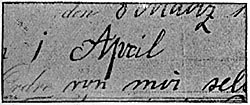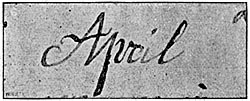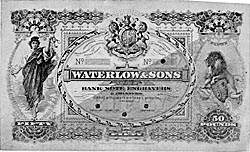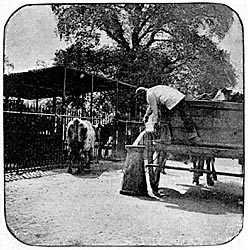Some Curiosities of Modern Photography. Part I.
By William G. FitzGerald
 |
Here is another of Dr. Jeserich's cases. A murderer, upon whose axe marks of blood had been found, declared he had killed a goat eight days before his arrest; human blood corpuscles, however, were found upon the axe, and were photographically compared with authentic goat's blood. In this case, photography, besides plainly showing the difference between the corpuscles, brought other evidence by proclaiming that the axe had been wiped after the deed. One photograph, produced at the trial, showed a place in point—much magnified—on the steel of the axe. It indicated plainly the streaks caused by wiping.
The practical application of photography to the detection of the falsification of handwriting is extremely interesting. In enlarged photographic pictures, erasures, alterations, and subtle differences in inks are clearly defined.
Fig. 8 shows a portion of a bill of exchange. No special difference in the writing is noticeable, not even in the word " April." The ink appears to be everywhere of the same colour, and this photo. appears to the eye to be identical with the original itself.
 |  |
It is evident that instead of April, the word " Mai" (May) was originally written. In this case it was the forger's intention to make the bill payable at an earlier date.
Dr. Jeserich has had many cases of this kind. One name has been found under another on a bill; manipulations of figures upon cheques have been proved on several occasions; and even tricky Austro-Prussian drovers, who alter dates on their cattle quarantine permits, are bowled out while they are chuckling over their own astuteness.
One more instance, showing how photography cleared an innocent man. A forester was found dead in a wood, and by his side was found part of a vulcanite match-box, which bore certain scratches suggestive of letters. The Public Prosecutor arrested one Gottlieb Graeber, and sent the box to Dr. Jeserich to see if that expert could decipher the name of the suspected man thereon. The eminent chemist powdered the matchbox with fine lycopodium and then wiped it carefully, so that the fine white particles remained in the scratches. An enlarged photograph of the box in this condition showed that the name engraved was not Gottlieb Graeber, but Adolf Langer. The latter worthy was subsequently hanged.
Dr. Jeserich was once called upon to say whether a certain old man, whose charred remains were found in the ruins of his house, had been alive when the house took fire. It was something of a poser; but after procuring a bare ten drops of blood from the old man's heart, the chemist tested them spectroscopically and found no trace of carbonic oxide in the blood; consequently the old man must have been dead when the fire broke out.
I may say that the forger can never hope to baffle photography. Captain Abuey, C. B., the vice-president of the Royal Photographic Society, was once requested to examine an engraving for a famous and titled collector. By means of photography, he brought out the original signature under a spurious one, which had been added to increase the value.
Nor is it generally known that at Waterlow's, the famous bank-note and cheque printers, there is a staff of photographic experts, who practically defend the Governments of the world against the skilful forger. This being so, it was clearly my duty to call upon Waterlow's chief expert, Mr. J. D. Geddes, and this gentleman I have to thank for much valuable information.
I am indebted to the courtesy of Mr. Phillip Waterlow for the accompanying reproductions, showing bank-notes with and without a protective printing (Fig. 10). The illustration shows two note designs cut in half diagonally and joined. The upper portion shows effective photographing of the design when no protective printing is employed. The lower half shows non-effective attempt to photograph the same design when protected against photographic copying. It is by no means generally known that our own Bank of England notes can be reproduced in absolute facsimile—even to the watermarks—by means of photography. Mr. J. Traill Taylor, editor of the British Journal of Photography, than whom, by the way, there is no more eminent expert in the world tells me he was once sent for by the chief engraver at the Bank of England.
 |
Foreign Governments frequently send specimens of new issues of bank-notes to Waterlow's, in order that the experts may find by photography whether it is possible to forge such notes. A fourth-rate Continental Power recently ordered a series of bank-notes from an Austrian firm, and after having been assured that they were not forgeable, even by photography, the notes were put in circulation.
Presently the whole country was inundated with bogus notes of marvellously clever design, whereupon the entire issue was called in, and a few specimens forwarded to Messrs. Waterlow, to see if, after all, the note could really be reproduced by photography.
The result was interesting. The note had a violet surface with a so-called protective under-printing of orange, meant to baffle the camera. Nevertheless, the London firm's expert staff quickly "got behind" the protection by using—as the forgers must have done—colour-blind plates. Specimens and photographic reproductions were then sent to the aggrieved Government, who subsequently requested Messrs. Waterlow to prepare an absolutely unforgeable note, if such a thing were possible, and forward samples.
The note produced in answer to this appeal must have been a disagreeable surprise to many expert forgers. By means of printing in certain salts of iron and other chemicals, the word "Counterfeit" appeared right across the face of every one photographed; yet on any one original it was impossible to detect anything unusual.
Banks occasionally send in cheques to Waterlow's photographic staff for investigation. No matter how well words and figures have been obliterated by means of chloride of lime and oxalic acid, the searching eye of the camera, appealed to by the iron in the original ink, brings out the visually invisible characters. Even when Chinese white pigment is used for obliterating purposes, the photographic eye pierces through. The French Government, I learn, suffered severely until it adopted a special paper into which strong fibre-like hair is woven. This again defeats the photographic forger, since the hairs are so strongly marked in facsimiles, that a child could detect the fraud.
 |
 |